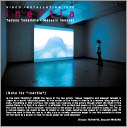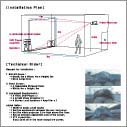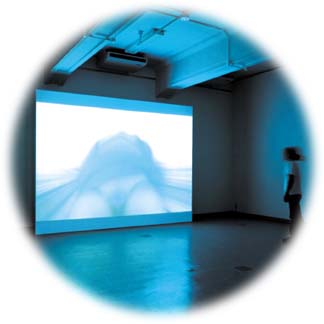Masashi IWASAKI






collaboration with Tadasu TAKAMINE
"INERTIA"
SEP 22 - NOV 15, 1998
Ecole Nationale Superieure des Beaux-Arts, France
高嶺格との共作
“慣性”
1998年9月22日−11月15日
パリ国立高等美術学校,フランス


"NOTE FOR INERTIA" DVD INLAY CARD "INERTIA", 1998
 n the work "Inertia" the focus of the two artists Tadasu Takamine and Masashi Iwasaki is Japan as a world industrial power. At the center of the frame in Inertia is a woman lying against a train. Travelling at 300km/h, this super train express is the artery though which the blood of the nation flows. It is fast, it is clean, it is efficient, it is perfect and above all it is powerful. The girl on the train seems to be in constant resistance to the power of the train and unable to jump off. Yet at a second glance, we might be led to doubt. Is she really resisting the speed or in cahoots with it? Does she want to hide her sex or is she, slyly or naively, somehow eager to use this occasion to show off her body to a public of men no doubt eager for such displays?
n the work "Inertia" the focus of the two artists Tadasu Takamine and Masashi Iwasaki is Japan as a world industrial power. At the center of the frame in Inertia is a woman lying against a train. Travelling at 300km/h, this super train express is the artery though which the blood of the nation flows. It is fast, it is clean, it is efficient, it is perfect and above all it is powerful. The girl on the train seems to be in constant resistance to the power of the train and unable to jump off. Yet at a second glance, we might be led to doubt. Is she really resisting the speed or in cahoots with it? Does she want to hide her sex or is she, slyly or naively, somehow eager to use this occasion to show off her body to a public of men no doubt eager for such displays?
(Tadasu TAKAMINE, Masashi IWASAKI)
“慣性についての覚え書き” DVDインレイカード “慣性” ,1998
 性」において、高嶺格と岩崎正嗣の二人のアーティストが焦点を当てたのは、世界的工業国としての日本である。スクリーンの中央には、列車の上に仰向けに横たわる女性が映しだされる。時速300キロで走行するこの超特急列車は、日本という国家の大動脈だ。−速くて、簡潔で、効率的で、完全無欠で、そしてなんといってもパワフル。一見すると列車の上の女性は、列車の力に絶えず抵抗しながらも飛び降りれないでいるように見える。しかしもっとよく見てみると、どうやらそういうわけでもないような気がしてくる。彼女はほんとうに列車のスピードに抵抗しているのだろうか? むしろ、速さと共謀し結託しているのではなかろうか? 彼女はほんとうに恥部を隠したがっているのだろうか? いや、もしかすると彼女は何らかの理由から−某かの下心があって、あるいは単なる無邪気さから−自分の体を、それを明らかに見たがっている男性の観客たちに見せたがっているのではあるまいか?
性」において、高嶺格と岩崎正嗣の二人のアーティストが焦点を当てたのは、世界的工業国としての日本である。スクリーンの中央には、列車の上に仰向けに横たわる女性が映しだされる。時速300キロで走行するこの超特急列車は、日本という国家の大動脈だ。−速くて、簡潔で、効率的で、完全無欠で、そしてなんといってもパワフル。一見すると列車の上の女性は、列車の力に絶えず抵抗しながらも飛び降りれないでいるように見える。しかしもっとよく見てみると、どうやらそういうわけでもないような気がしてくる。彼女はほんとうに列車のスピードに抵抗しているのだろうか? むしろ、速さと共謀し結託しているのではなかろうか? 彼女はほんとうに恥部を隠したがっているのだろうか? いや、もしかすると彼女は何らかの理由から−某かの下心があって、あるいは単なる無邪気さから−自分の体を、それを明らかに見たがっている男性の観客たちに見せたがっているのではあるまいか?
 性」において、高嶺格と岩崎正嗣の二人のアーティストが焦点を当てたのは、世界的工業国としての日本である。スクリーンの中央には、列車の上に仰向けに横たわる女性が映しだされる。時速300キロで走行するこの超特急列車は、日本という国家の大動脈だ。−速くて、簡潔で、効率的で、完全無欠で、そしてなんといってもパワフル。一見すると列車の上の女性は、列車の力に絶えず抵抗しながらも飛び降りれないでいるように見える。しかしもっとよく見てみると、どうやらそういうわけでもないような気がしてくる。彼女はほんとうに列車のスピードに抵抗しているのだろうか? むしろ、速さと共謀し結託しているのではなかろうか? 彼女はほんとうに恥部を隠したがっているのだろうか? いや、もしかすると彼女は何らかの理由から−某かの下心があって、あるいは単なる無邪気さから−自分の体を、それを明らかに見たがっている男性の観客たちに見せたがっているのではあるまいか?
性」において、高嶺格と岩崎正嗣の二人のアーティストが焦点を当てたのは、世界的工業国としての日本である。スクリーンの中央には、列車の上に仰向けに横たわる女性が映しだされる。時速300キロで走行するこの超特急列車は、日本という国家の大動脈だ。−速くて、簡潔で、効率的で、完全無欠で、そしてなんといってもパワフル。一見すると列車の上の女性は、列車の力に絶えず抵抗しながらも飛び降りれないでいるように見える。しかしもっとよく見てみると、どうやらそういうわけでもないような気がしてくる。彼女はほんとうに列車のスピードに抵抗しているのだろうか? むしろ、速さと共謀し結託しているのではなかろうか? 彼女はほんとうに恥部を隠したがっているのだろうか? いや、もしかすると彼女は何らかの理由から−某かの下心があって、あるいは単なる無邪気さから−自分の体を、それを明らかに見たがっている男性の観客たちに見せたがっているのではあるまいか?
(高嶺格・岩崎正嗣)
Photograph: Hiroshi HASEGAWA
写真:長谷川博士

"ICON OF TECHNOLOGY" EXHIBITION CATALOG "DONAI YANEN!", 1998
 hinkansen has long been a symbol of the technological strength of modern Japan. This superfast train project was initiated in 1959, just when the International Olympic Committee selected Tokyo as the venue for the 1964 Olympics. In this golden age of the Nippon economy, the preparation for the games provided the Japanese people with the affirmation of their new economic power, doubled by the international recognition that had been so much anticipated. Proudly, the whole county, as well as the capital, turned itself into an incredible construction site, where expressways, elevated roads, and spacious avenues emerged to replace intricate meshes of narrow alleys while newly-built concrete tours formed barriers between roads with a flood of cars and densely built-up areas with small traditional houses given a suspended sentence. Without caring for peripheral inhabitants, the Japanese government and general construction firms thus built a railroad between Tokyo-Osaka for the future train; the countryside bled for the project without anything to be paid in return. Progress was so cold-blooded. Today, falling behind the French TGV in running speed, Shinkansen has been still a symbol for the people who travel well around their country. It is why Iwasaki and Takamine chose this icon of technology for the inspiration of their first collaboration. While they are both devoted to new technologies and computer graphics, their creative approach is simply minimal and realistic: they set up a video camera on the exterior of the motive car of the superfast train to shoot the way from Nagoya to Tokyo, a 2-hour journey. Oh, what an incredible project it is! What the video presents is nothing but tremendous rumbling and fuzzy images: we can see none of scenes including the moment of the departure from Nagoya and that of arrival at Tokyo as well as tea plantations and Mt. Fuji on the way. In 1895, one of the two brothers had invented cinematography, shooting a moving train with a camera fixed. A century later, the two young Japanese artists demonstrate the contrary to the principle of reality: the camera must be immobile in order to express speed.
hinkansen has long been a symbol of the technological strength of modern Japan. This superfast train project was initiated in 1959, just when the International Olympic Committee selected Tokyo as the venue for the 1964 Olympics. In this golden age of the Nippon economy, the preparation for the games provided the Japanese people with the affirmation of their new economic power, doubled by the international recognition that had been so much anticipated. Proudly, the whole county, as well as the capital, turned itself into an incredible construction site, where expressways, elevated roads, and spacious avenues emerged to replace intricate meshes of narrow alleys while newly-built concrete tours formed barriers between roads with a flood of cars and densely built-up areas with small traditional houses given a suspended sentence. Without caring for peripheral inhabitants, the Japanese government and general construction firms thus built a railroad between Tokyo-Osaka for the future train; the countryside bled for the project without anything to be paid in return. Progress was so cold-blooded. Today, falling behind the French TGV in running speed, Shinkansen has been still a symbol for the people who travel well around their country. It is why Iwasaki and Takamine chose this icon of technology for the inspiration of their first collaboration. While they are both devoted to new technologies and computer graphics, their creative approach is simply minimal and realistic: they set up a video camera on the exterior of the motive car of the superfast train to shoot the way from Nagoya to Tokyo, a 2-hour journey. Oh, what an incredible project it is! What the video presents is nothing but tremendous rumbling and fuzzy images: we can see none of scenes including the moment of the departure from Nagoya and that of arrival at Tokyo as well as tea plantations and Mt. Fuji on the way. In 1895, one of the two brothers had invented cinematography, shooting a moving train with a camera fixed. A century later, the two young Japanese artists demonstrate the contrary to the principle of reality: the camera must be immobile in order to express speed.
写真:長谷川博士

"ICON OF TECHNOLOGY" EXHIBITION CATALOG "DONAI YANEN!", 1998
 hinkansen has long been a symbol of the technological strength of modern Japan. This superfast train project was initiated in 1959, just when the International Olympic Committee selected Tokyo as the venue for the 1964 Olympics. In this golden age of the Nippon economy, the preparation for the games provided the Japanese people with the affirmation of their new economic power, doubled by the international recognition that had been so much anticipated. Proudly, the whole county, as well as the capital, turned itself into an incredible construction site, where expressways, elevated roads, and spacious avenues emerged to replace intricate meshes of narrow alleys while newly-built concrete tours formed barriers between roads with a flood of cars and densely built-up areas with small traditional houses given a suspended sentence. Without caring for peripheral inhabitants, the Japanese government and general construction firms thus built a railroad between Tokyo-Osaka for the future train; the countryside bled for the project without anything to be paid in return. Progress was so cold-blooded. Today, falling behind the French TGV in running speed, Shinkansen has been still a symbol for the people who travel well around their country. It is why Iwasaki and Takamine chose this icon of technology for the inspiration of their first collaboration. While they are both devoted to new technologies and computer graphics, their creative approach is simply minimal and realistic: they set up a video camera on the exterior of the motive car of the superfast train to shoot the way from Nagoya to Tokyo, a 2-hour journey. Oh, what an incredible project it is! What the video presents is nothing but tremendous rumbling and fuzzy images: we can see none of scenes including the moment of the departure from Nagoya and that of arrival at Tokyo as well as tea plantations and Mt. Fuji on the way. In 1895, one of the two brothers had invented cinematography, shooting a moving train with a camera fixed. A century later, the two young Japanese artists demonstrate the contrary to the principle of reality: the camera must be immobile in order to express speed.
hinkansen has long been a symbol of the technological strength of modern Japan. This superfast train project was initiated in 1959, just when the International Olympic Committee selected Tokyo as the venue for the 1964 Olympics. In this golden age of the Nippon economy, the preparation for the games provided the Japanese people with the affirmation of their new economic power, doubled by the international recognition that had been so much anticipated. Proudly, the whole county, as well as the capital, turned itself into an incredible construction site, where expressways, elevated roads, and spacious avenues emerged to replace intricate meshes of narrow alleys while newly-built concrete tours formed barriers between roads with a flood of cars and densely built-up areas with small traditional houses given a suspended sentence. Without caring for peripheral inhabitants, the Japanese government and general construction firms thus built a railroad between Tokyo-Osaka for the future train; the countryside bled for the project without anything to be paid in return. Progress was so cold-blooded. Today, falling behind the French TGV in running speed, Shinkansen has been still a symbol for the people who travel well around their country. It is why Iwasaki and Takamine chose this icon of technology for the inspiration of their first collaboration. While they are both devoted to new technologies and computer graphics, their creative approach is simply minimal and realistic: they set up a video camera on the exterior of the motive car of the superfast train to shoot the way from Nagoya to Tokyo, a 2-hour journey. Oh, what an incredible project it is! What the video presents is nothing but tremendous rumbling and fuzzy images: we can see none of scenes including the moment of the departure from Nagoya and that of arrival at Tokyo as well as tea plantations and Mt. Fuji on the way. In 1895, one of the two brothers had invented cinematography, shooting a moving train with a camera fixed. A century later, the two young Japanese artists demonstrate the contrary to the principle of reality: the camera must be immobile in order to express speed.
(Eric MEZIL, Independent Curator)
“テクノロジーのイコン” 展覧会カタログ “どないやねん!” ,1998
 幹線は、長いあいだ現代日本のテクノロジーの目玉商品だった。この高速列車の企画は、1959年、つまり国際オリンピック協会が東京を64年のオリンピックの開催地に選んだ年に生まれた。日本経済のこの黄金時代、オリンピックの開催準備は日本人にとってはとくに、新たな経済力の表明と、長いあいだ求められていた国際的承認とにつながった。人々は意気揚々とし、首都東京と国土全体は目を疑うような工事現場と化した。幹線道路や高架の高速道路が矢継ぎ早にでき、入り組んだ路地が壊されて大通りが開かれ、解体を免れた日本独特の小さな家々と車の流れとのあいだに壁を作るようにしてビルが建設された。沿線の住民を無視して、公共事業を請け負う建設会社と政府は、東京−大阪間の軸上に、未来の列車のために道を拓いた。その結果、田園は得るものは何もなしに、文字どおり出血した。進歩には、代価も心もなかった。現在、速さにかけてはフランスのTGVに後塵を排していても、新幹線は国内をよく旅行する人々にとって、やはり象徴的な意味を持っている。だからこそ、岩崎と高嶺は初の共同作業として、新幹線というテクノロジーのイコンを選んだ。二人ともニュー・テクノロジーとコンピュータ・グラフィックスに夢中だが、ヴィデオ・インスタレーションの手法はミニマルでリアリスティックだ。彼らは、名古屋−東京間を走る動力車の胴体にカメラを取り付け、2時間の道中を撮影した。不思議なプロジェクトだ。スピードのため景色などわからず、耳をつんざくような轟音とぼんやりしたイメージしか、そこにはない。名古屋から出たところも、茶畑も、富士山も、東京への到着も、何ひとつ見えない‥。1895年、ある二人の兄弟が走行中の列車を固定したカメラで撮影しようとして、映画を発明した。100年後、日本の二人の若者は、この現実原則をさかさまに証明した。つまりスピードを表現するためには動きを止めなければならないのだ。
幹線は、長いあいだ現代日本のテクノロジーの目玉商品だった。この高速列車の企画は、1959年、つまり国際オリンピック協会が東京を64年のオリンピックの開催地に選んだ年に生まれた。日本経済のこの黄金時代、オリンピックの開催準備は日本人にとってはとくに、新たな経済力の表明と、長いあいだ求められていた国際的承認とにつながった。人々は意気揚々とし、首都東京と国土全体は目を疑うような工事現場と化した。幹線道路や高架の高速道路が矢継ぎ早にでき、入り組んだ路地が壊されて大通りが開かれ、解体を免れた日本独特の小さな家々と車の流れとのあいだに壁を作るようにしてビルが建設された。沿線の住民を無視して、公共事業を請け負う建設会社と政府は、東京−大阪間の軸上に、未来の列車のために道を拓いた。その結果、田園は得るものは何もなしに、文字どおり出血した。進歩には、代価も心もなかった。現在、速さにかけてはフランスのTGVに後塵を排していても、新幹線は国内をよく旅行する人々にとって、やはり象徴的な意味を持っている。だからこそ、岩崎と高嶺は初の共同作業として、新幹線というテクノロジーのイコンを選んだ。二人ともニュー・テクノロジーとコンピュータ・グラフィックスに夢中だが、ヴィデオ・インスタレーションの手法はミニマルでリアリスティックだ。彼らは、名古屋−東京間を走る動力車の胴体にカメラを取り付け、2時間の道中を撮影した。不思議なプロジェクトだ。スピードのため景色などわからず、耳をつんざくような轟音とぼんやりしたイメージしか、そこにはない。名古屋から出たところも、茶畑も、富士山も、東京への到着も、何ひとつ見えない‥。1895年、ある二人の兄弟が走行中の列車を固定したカメラで撮影しようとして、映画を発明した。100年後、日本の二人の若者は、この現実原則をさかさまに証明した。つまりスピードを表現するためには動きを止めなければならないのだ。
 幹線は、長いあいだ現代日本のテクノロジーの目玉商品だった。この高速列車の企画は、1959年、つまり国際オリンピック協会が東京を64年のオリンピックの開催地に選んだ年に生まれた。日本経済のこの黄金時代、オリンピックの開催準備は日本人にとってはとくに、新たな経済力の表明と、長いあいだ求められていた国際的承認とにつながった。人々は意気揚々とし、首都東京と国土全体は目を疑うような工事現場と化した。幹線道路や高架の高速道路が矢継ぎ早にでき、入り組んだ路地が壊されて大通りが開かれ、解体を免れた日本独特の小さな家々と車の流れとのあいだに壁を作るようにしてビルが建設された。沿線の住民を無視して、公共事業を請け負う建設会社と政府は、東京−大阪間の軸上に、未来の列車のために道を拓いた。その結果、田園は得るものは何もなしに、文字どおり出血した。進歩には、代価も心もなかった。現在、速さにかけてはフランスのTGVに後塵を排していても、新幹線は国内をよく旅行する人々にとって、やはり象徴的な意味を持っている。だからこそ、岩崎と高嶺は初の共同作業として、新幹線というテクノロジーのイコンを選んだ。二人ともニュー・テクノロジーとコンピュータ・グラフィックスに夢中だが、ヴィデオ・インスタレーションの手法はミニマルでリアリスティックだ。彼らは、名古屋−東京間を走る動力車の胴体にカメラを取り付け、2時間の道中を撮影した。不思議なプロジェクトだ。スピードのため景色などわからず、耳をつんざくような轟音とぼんやりしたイメージしか、そこにはない。名古屋から出たところも、茶畑も、富士山も、東京への到着も、何ひとつ見えない‥。1895年、ある二人の兄弟が走行中の列車を固定したカメラで撮影しようとして、映画を発明した。100年後、日本の二人の若者は、この現実原則をさかさまに証明した。つまりスピードを表現するためには動きを止めなければならないのだ。
幹線は、長いあいだ現代日本のテクノロジーの目玉商品だった。この高速列車の企画は、1959年、つまり国際オリンピック協会が東京を64年のオリンピックの開催地に選んだ年に生まれた。日本経済のこの黄金時代、オリンピックの開催準備は日本人にとってはとくに、新たな経済力の表明と、長いあいだ求められていた国際的承認とにつながった。人々は意気揚々とし、首都東京と国土全体は目を疑うような工事現場と化した。幹線道路や高架の高速道路が矢継ぎ早にでき、入り組んだ路地が壊されて大通りが開かれ、解体を免れた日本独特の小さな家々と車の流れとのあいだに壁を作るようにしてビルが建設された。沿線の住民を無視して、公共事業を請け負う建設会社と政府は、東京−大阪間の軸上に、未来の列車のために道を拓いた。その結果、田園は得るものは何もなしに、文字どおり出血した。進歩には、代価も心もなかった。現在、速さにかけてはフランスのTGVに後塵を排していても、新幹線は国内をよく旅行する人々にとって、やはり象徴的な意味を持っている。だからこそ、岩崎と高嶺は初の共同作業として、新幹線というテクノロジーのイコンを選んだ。二人ともニュー・テクノロジーとコンピュータ・グラフィックスに夢中だが、ヴィデオ・インスタレーションの手法はミニマルでリアリスティックだ。彼らは、名古屋−東京間を走る動力車の胴体にカメラを取り付け、2時間の道中を撮影した。不思議なプロジェクトだ。スピードのため景色などわからず、耳をつんざくような轟音とぼんやりしたイメージしか、そこにはない。名古屋から出たところも、茶畑も、富士山も、東京への到着も、何ひとつ見えない‥。1895年、ある二人の兄弟が走行中の列車を固定したカメラで撮影しようとして、映画を発明した。100年後、日本の二人の若者は、この現実原則をさかさまに証明した。つまりスピードを表現するためには動きを止めなければならないのだ。

